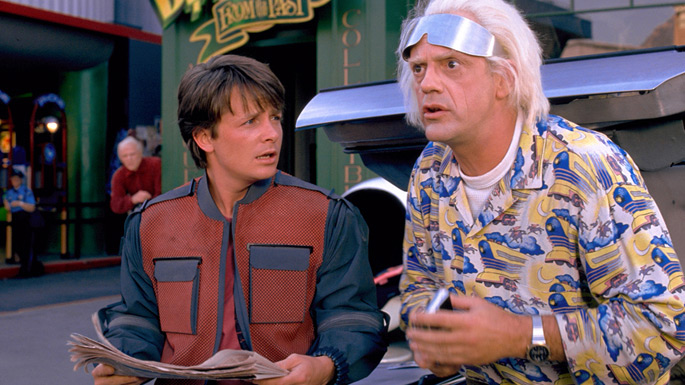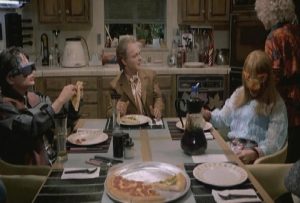Back to the Future, Part II
There’s an old adage among novelists: you have an eternity to write your first novel and 6 months to write your second. Writing team Robert Zemeckis and Bob Gale spent four years working on the script for the first Back to the Future, polishing the draft as studio after studio rejected it. When they finally got a deal, they made one of the best time-travel movies ever. At the time, the two considered BttF a one-shot movie. Sure the film ends with Mrty McFly (Michael J. Fox), his girlfriend Jennifer (Claudia Wells) and best friend Doc Brown (Christopher Lloyd) headed to the brave then-unknown year of 2015, but Zemeckis and Gale considered the story told.
Of course, BttF made close to $400 million on a $20 million budget. Hollywood being Hollywood demanded a sequel. While their writing time was’t as short as six months, Zemeckis and Gale had half the time (two years) to come up with a shooting draft. This abbreviated gestation time, coupled with some sticky casting issues, means BttFII is a much messier film than I remember from childhood.
The Writing
I’ll give credit where credit is due: Zemeckis and Gale juggled a lot of timelines in this movie. There’s the original 1985, then 2015, 1985A (caused by a divergence in the timeline), and finally 1955, which is affected by the presence of two McFlys and two Browns. Given the intricacies of time-travel stories, there are so many opportunities for plot holes.
Still, this one I cannot excuse, because it’s such a major one. Once Old Biff steals the time machine in 2015 and returns to 1955, he shouldn’t have returned. If anything, he would have brought the time machine to a divergent timeline (2015A), much like Doc and Marty travelled to their divergent 1985A. Doc even spells out this paradox for Marty in 1985A, stating that if they were to travel further in the future, they would only continue further along the divergent timeline. Old Biff should have never returned to 2015; once he went back in time he would have changed his future. (For other examples of BttF paradoxes, check out this post by Den of Geek.)
Paradoxes aside, the writing in BttFII is a bit messy. It’s in the second movie that the audience is introduced to Marty’s inability to back down from anything, simply if someone calls him chicken. It’s an attribute not found anywhere in the first film and becomes Marty’s sole driving trait, which in turn lazily fuels the plot. I don;t buy it. In the first film, Marty is determined to prove his self-worth because he needs to be better than his parents, not out of some insecure desire to have people think he’s brave. This plot point gets used too often throughout BttFII, but it’s almost done out of necessity; for the second movies we have fewer cast members for Michael J. Fox to act against.
The Casting
I never realized how much Crispin Glove brought to the first BttF until I noticed his conspicuous absence in the sequels. Glover’s compensation fights with the producers of BttF are well documented (Wikipedia has a good short write-up), and it’s sad the writers chose to tone down the role in response. Zemeckis and Gale probably guessed their replacement (Jeffery Weissman) wouldn’t bring the same gravitas as Glover. However, on my last rewetting of BttF I noticed that despite the focus on Marty and Doc, the movie feels very much like an ensemble piece. Everyone in the first BttF is necessary for the plot, and they all deliver. Without original members Glover and Claudia Wells, BttFII loses that character-driven magic. Wissman and Elisabeth Shue (who replaced Wells) aren’t given much of a chance to drive the story; their screen time is severely cut from the first film. This is especially puzzling regarding Shue; at the end of BttF Doc tells Marty to bring Jennifer along to the future, only to knock her out within the first ten minutes of the movie. This was a wasted opportunity to have Marty act against someone other than the Doc, and Shue’s presence is reduced to screaming damsel in distress.
I have another issue with the casting of BttFII and that’s the decision to have Michael J. Fox play 4 characters. While supporting cast members Lea Thompson and Thomas F. Wilson both successfully played future and past versions of themselves (especially Wilson, whom I’ll talk about more next week in my review of part III), I could not relate to Marty’s future family at all. This is especially true for Marty’s daughter Marlene McFly, played by Fox. While as a child I found Fox’s multiple character portrayal humorous (much in the same way I enjoyed Eddie Murphy’s penchant for the same thing), adult me just finds Marlene McFly problematic and sad. Couldn’t they have gotten other actors to fill those roles?
One good thing is that BttFII feels like a complete movie more so than other “Part Twos.” The franchise could have ended here and I’d bee happy. But it didn’t, so instead we get Back to the Future, Part III.
To be concluded…
tl;drs
Blank is a blanker version of blank: Back to the Future, Part II is retread of the first BttF, with way more plot holes.
Screen credits over/under: Under. It’s still Zemeckis’s and Gale’s baby, only the limited time they had for rewrites (no pun intended) shows through.
Recommended if you like: Inception and self-referential meta movies.
Better than I expected: The third act still holds up, with its many examples of causality.
Worse than I hoped: The loss of Crispin Glover and Claudia Wells really hurts the ensemble feeling we had in the first film.
Back to the Future, Part II would work better as a(n): I would happier if the first BttF had been a one-off, as Zemeckis intended.
Verdict: BttFII has a great premise, but suffers from recasting and time constraints.





